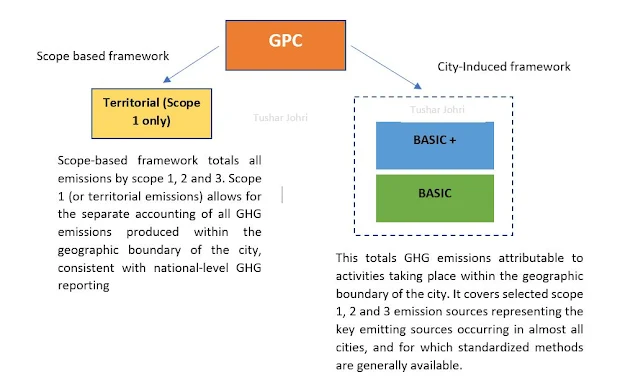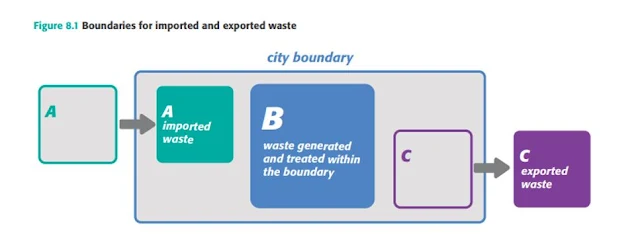GARP SCR: Understanding BASIC and BASIC+ (Part 2/2)
- Get link
- X
- Other Apps
This is the 2nd part of the article. in case, you have NOT read the 1st part of the article. You can read the 1st part of the article here (click here).
In the 2nd part of the article on understanding GPC BASIC and BASIC+, we will go into the details of the frameworks defined by GPC.
So, how does the report structure look like using both the above
frameworks? Here it is.
Let us focus more on BASIC and BASIC +
BASIC + | BASIC | |
Stationary energy | Yes | Yes |
Transportation | Yes | Yes |
Waste | Yes | Yes |
AFOLU | Yes | - |
IPPU | Yes | - |
Below table shows the details with sectors and sub-sectors and what all emissions are reported under each scope. The table is worth studying and identifying various interesting trends to take a note of. These trends will help you understand the way accounting and reporting is done under BASIC and BASIC+. Shall we start noting down the trends?
1. Stationary energy:
I.
Scope 1 is the emissions due to the fuel being
consumed within the buildings – commercial, residential, factories, mining operations,
refineries etc..
II.
Scope 2 denotes electricity from the grid. In
fact, whenever you come across the word “electricity” anywhere, it has to be scope
2. This is true even in the case of an electricity generation unit within
the boundary of the city. Try to think why? Please share your thoughts in the
comment section.
III.
Scope 3 is the emissions from transmission and
distribution (T&D) losses of the electricity through the grid outside the city
boundary. Please note BASIC reporting doesn’t report Scope 3 or T&D losses
while BASIC+ reports.
2. Transportation:
I.
Scope 1 is the emissions from all the vehicles
within the boundary of the city.
II.
Scope 2 denotes vehicles using electricity
from the grid within the city boundary. In fact, whenever you come across
the word “electricity” anywhere, it has to be scope 2. This is true
in the case of an electricity generation unit within the boundary of the city.
III.
Scope 3 is the emissions from trans-boundary
journeys.
IV.
Those journeys across the city where both the origin
and destination are outside the boundary of the city may or may not be
considered by the city for emissions. Hence,I have marked it as “X”.
3.
Waste:
Above figure illustrates boundary considerations for emission sources in the Waste sector. In this figure, the blue border represents the city’s geographic boundary and:
• A illustrates waste
generated outside of the city boundary and treated within the boundary
• B illustrates waste generated and treated within the city’s
boundary
• C illustrates waste generated inside the boundary and treated
outside of the boundary Based on the above, the reporting requirement for the
Waste sector is as follows:
• Scope 1 emissions = emissions from A+B (all emissions generated
within the city boundary)
• Scope 3 emissions = emissions from C
• Emissions reported for BASIC and BASIC+ = emissions from B+C
(all emissions resulting from waste generated by the city)
Scope 1: Emissions from waste treated inside the city
This includes all GHG emissions from treatment and disposal of waste within the
city boundary regardless whether the waste is generated within or outside the
city boundary. Only GHG emissions from waste generated by the city shall be
reported under BASIC/BASIC+. GHG emissions from imported waste shall be
reported as scope 1, but not added to BASIC/BASIC+ totals.
Scope 2: Not applicable All emissions from the use of
grid-supplied electricity in waste treatment facilities within the city
boundary shall be reported under scope 2 in Stationary Energy, commercial and
institutional buildings and facilities (I.2.2).
Scope 3: Emissions from waste generated by the city but
treated outside the city This includes all GHG emissions from treatment of
waste generated by the city but treated at a facility outside the city
boundary.
Example:
City "A" produces certain solid waste of its own and treats it locally and emits 300 units of emissions. For treating water waste, "A" sends the water waste to a facility outside the city to another city "B". Its water waste treatment incurs 200 units of emissions. If BASIC reporting is used, what should be the emissions reported.
·
As per BASIC, only emissions that have
originated in the city must be considered. So, the waste that originates in the
city: Solid waste and Water waste.
4. IPPU: Cities shall report all GHG
emissions from IPPU in scope 1 under BASIC+ reporting only.
Scope 1:
Emissions from industrial processes and product uses occurring within the city
Note: Allocation
of emissions from the use of fossil fuel between the Stationary Energy and IPPU
sectors can be complex. The GPC follows IPCC Guidelines, which define “fuel
combustion” in an industrial process context as: “the intentional oxidation of
material within an apparatus that is designed to provide heat or mechanical
work to a process, or for use away from the apparatus.” Therefore:
· If the fuels are combusted for energy use, the
emission from fuel uses shall be counted under Stationary Energy.
· If the derived fuels are transferred for
combustion in another source category, the emissions shall be reported under
Stationary Energy.
· If combustion emissions from fuels are
obtained directly or indirectly from the feedstock, those emissions shall be
allocated to IPPU.
· If heat is released from a chemical reaction,
the emissions from that chemical reaction shall be reported as an industrial
process in IPPU.
To put it simply, if a fossil fuel or its derivative Is used for
heating purposes, the emissions from it should be reported under stationary
energy. On the other hand, if a fossil
fuel or its derivative is itself used as a raw material then the emissions from
it should be reported under IPPU.
·
Scope 2: Not applicable All emissions from
the use of grid-supplied electricity in industrial or manufacturing facilities
within the city boundary shall be reported under scope 2 in Stationary Energy
·
Scope 3: Other out-of-boundary emissions from
IPPU outside the city are not included in the inventory boundary.
5.
AFOLU:
Scope
1:
In-boundary emissions from agricultural activity, land use and land use change
within the city boundary. GHG emissions associated with the manufacture of
nitrogen fertilizers, which account for a large portion of agricultural
emissions, are not counted under AFOLU. IPCC Guidelines allocates these
emissions to IPPU
Scope
2: Not applicable Emissions from use of grid-supplied energy in
buildings and vehicles in farms or other agricultural areas shall be reported
in Stationary Energy and Transportation, respectively
Scope
3: Other out-of-boundary emissions from land-use activities outside
the city (e.g., agricultural products imported for consumption within the city
boundary) are not covered in the GPC under BASIC/ BASIC+
IPCC
Guidelines divides AFOLU activities into three categories:
•
Livestock - CO2 emissions from Livestock
are not estimated because annual net CO2 emissions are assumed to be zero—the
CO2 photosynthesized by plants is returned to the atmosphere as respired CO2. Livestock
production emits CH4 through enteric fermentation, and both CH4 and N2O through
management of their manure.
•
Land - Large quantities of GHG emissions can result as a consequence of a
change in land use. Examples include change of use from agriculture (e.g.,
urban farms) or parks, to another use (e.g., industrial development). When the
land use is changed, soil carbon and carbon stock in vegetation can be lost as
emissions of CO2.
•
Aggregate sources and non-CO2 emissions sources on land
Remember when a biomass is burnt without it
being put to a productive use, the emissions from it will be reported under
AFOLU. On the other hand, if the biomass is burnt and put to a productive use,
the emissions will be put under the Stationary energy category.
Example:
1)
If biomass pellets are burnt to heat up the water
in a boiler à Here
emissions will be reported under Stationary energy as the purpose is to do
something useful, “heating the boiler”.
2)
Wood blocks are used to heat up Pizza oven à Here emissions will be reported under
Stationary energy as the purpose is to do something useful, “heating the oven”.
3)
Forest wildfire à Same wood
burns without any use or practical use. In this case, emissions are reported
under AFOLU.
4)
Bonfire à Wood and biomass
burns without any practical use. In this case, emissions are reported
under AFOLU.
Summarizing:
Red encircle areas are reported for BASIC+. Remaining are reported under BASIC.
References:
- Global Protocol for Community-Scale Greenhouse Gas Emission Inventories document
- GTALCC Project
#GARP #SCR #BASIC #BASIC+ #GPC #Reporting
- Get link
- X
- Other Apps








.png)

Comments
Post a Comment
Please share your thoughts here. If possible, please share your name and email so that it is easy to connect.